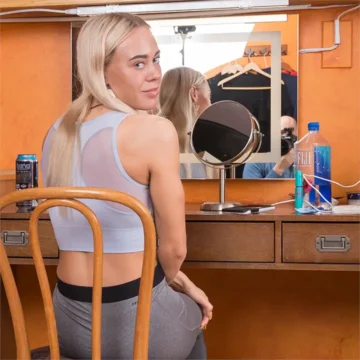An artist's budget: Where the money goes
When you buy a fine art photograph, you may wonder what the art photographer does with your money. You've put a portion of your hard-earned income away for an art-collecting budget; it's only natural to wonder about the financial aspect of being an artist. This article is a high-level view of how artist Aaron Knight spends revenue derived from the sale of limited-edition art photography. In order to sustain a business, the artist must continue to invest in the materials and activities that drive the creative side of being an artist.
Compensating teammates
A primary and obvious expense in photographing people is compensating those subjects who appear in front of the camera. Every person you see in a photograph by Aaron Knight has been monetarily compensated prior to the creation of the final art print. Offering competitive pay is important to attracting and retaining creative and talented collaborators for figure art photography.
A lot more goes into creating these artworks than just doing some photo shoots. In fact, more of the artist's time is spent without a camera in his hand than aiming a lens at the human form.
The artist also hires assistants to help with tasks that are either time-sensitive, labor-intensive, or otherwise challenging. Assistants may help with the setup and breakdown of a photo shoot, especially if elaborate sets are involved. Packing limited editions for shipment, as well as photo books, can benefit from additional labor, especially during periods of high demand and when there are many photo shoots scheduled.
Maintaining professional-grade equipment
The materials and labor to produce a single item may be the first thing that comes to mind when someone thinks of the cost to make a product. Once we consider the indirect costs, such as overhead, we can uncover many more major expenses.
Another major factor in the outcome of art photography is maintaining professional-grade equipment such as cameras, lenses, lighting, and studio equipment such as stands and booms. Because some equipment is specialized, such as underwater gear or film photography gear, there is more that goes into the photography kit than many people may realize. To cope with this expense, Knight buys used devices. Additionally, he is deliberately sparse in outfitting his studio, such as using only one lens per camera and buying lights that can fulfill multiple roles.

The maintenance of photography equipment requires spending on repairs and spare parts. Investing in redundant devices ensures minimal downtime and no missed photoshoot opportunities while waiting for equipment to be repaired or replaced.
The equipment to produce a photograph also includes computers and hard drives; these need to be periodically replaced. Software fees are no small part of the equation of producing photographs as well as marketing videos.
Making the tangible artwork
Printing artwork, as an incremental cost, is perhaps less of a financial factor than all of the other costs that lead up to that point. Using an owner-operated art printing business that specializes in serving fine artists, the printing expense covers the long-term cost of ink, printers, and its maintenance.
A place to work
Maintaining a studio, or finding other suitable places to work, are a necessary expense to creating innovative and varied artworks. Maintaining a studio space requires rent or other payments, whether for a day or perpetually, to cover the costs of real estate, upkeep, and utilities. Sets, including furniture to climb on are another expense in the form of required labor and materials.
Regardless of where I conduct a photo shoot, there is typically a cost involved. Even if the shoot takes place in my backyard, I initially purchased the property and have invested in its upkeep, for instance building a waterfall or other sets for photoshoots.
Travel to New York, the desert southwest, Los Angeles, or Florida has played a role in achieving the scenery and on-camera participants that Aaron Knight seeks in crafting particular images. Transportation, lodging, and meals are all routine expenses for any business travel, and being a self-employed artist is no different. For some projects, such as in The Bahamas, the upfront investment in transporting all of the participants can be substantial. There is a certain financial degree of risk involved, given no guarantees for weather, that not every idea will result in an artwork, and artworks in a limited edition are sold over a stretch of time.

Continuing the work
Various overhead costs include paying interest on business loans, fees for tax preparation and legal consultations, and various business licensing fees and other taxes. Transaction costs apply to each sale that is made. Things like web hosting round out other miscellaneous costs.
Art dealers take a cut of every transaction that goes through their platform, as does Kickstarter.
In order to continually create artwork, an artist must live. This means the sale of the artwork must not only cover the costs of running the business, but the living expenses of the artist. No business run without employees, and employees, even the owner of a business, can't work for free. Basic necessities such as food, shelter, and healthcare are just a few of the expenses that an artist must cover in order to survive and continue to make art full time.
